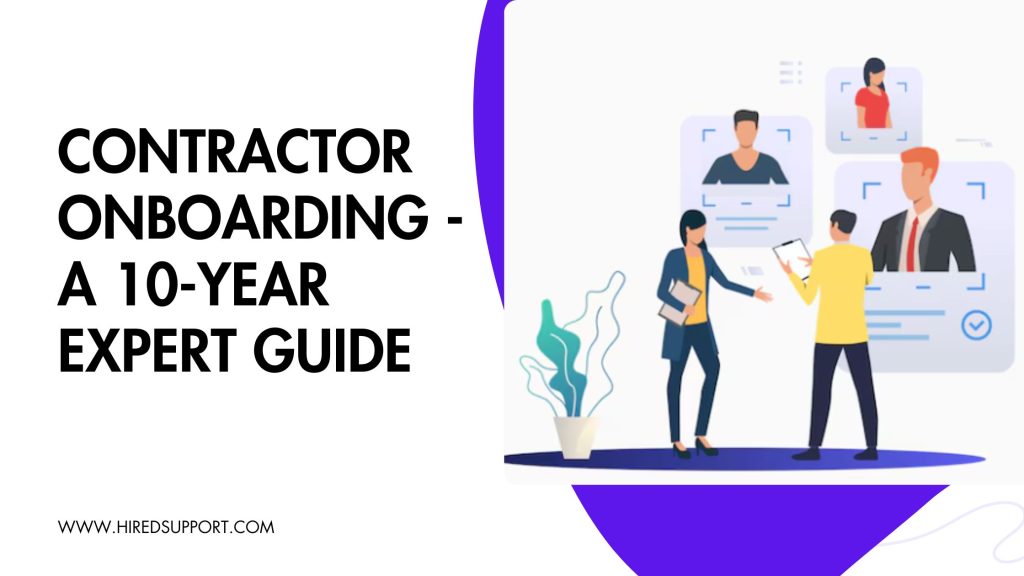As the president of a leading outsourcing company, I have dealt with numerous contracts over a period of 10 years.
From my experience, mishandling your onboarding contracts can subject you to many legal consequences and may also put your business at risk.
For example, there’s a famous case called ‘The Hairy Hand’ in which the doctor promised a specific output for the skincare treatment. However, after finding the unexpected results, the patient launched a legal case against the doctor.
See, everything we write or do in a business is open to legal consequences, and if not done right, it can put us in an uncomfortable situation.
In addition to these legal consequences, I have discussed all the steps of onboarding, which will save you from legal consequences and help you make better decisions.
9 Steps of Contract Onboarding in 2024

The following are the top 9 steps that will help to set the right expectations with your contractor:
- Gather the Personal Details of a Contractor
- Make Sure you Cover the Tax Obligations
- Get your Confidentiality Agreement Signed by the Contractor
- Specify All the Work Details under the Legal Contract
- Get Overtime Policies Defined in Advance
- Make the Welcome Note Short and Useful
- Make Your Contractor Aware of the Company’s Policies & Culture
- Create a Resource Guide for Your Contractor
- Create a Feedback System & Clear KPIs
In the coming section, I will discuss each one of them in detail.
1. Gather the Personal Details of a Contractor
Before onboarding any client or employee, gathering all the necessary documentation from the concerned person is essential. It helps to deal with emergencies and respond effectively.
I have mentioned the details you need to note:
- Full legal name
- Permanent address
- Temporary address
- Date of birth
- Bank account details
- Personal and emergency contact numbers
- Social Security Number (SSN) or equivalent in other countries
- National ID number
Please note that you may also need to provide additional details about the person depending on the job you are hiring for.
2. Make Sure you Cover the Tax Obligations
Before I mention what kind of tax forms you need for an independent contractor in the USA, I’d advise you to clearly distinguish between an independent contractor and an employee.
Often, people don’t know how to distinguish between them, and this can result in filing the taxes with the wrong information.
Note: Filing the wrong taxes may also result in legal and sometimes criminal penalties.
Following are some of the factors the IRS uses to categorize an employee or contractor:
- Does the company have control over the workers?
- How does the worker get paid?
- Does the worker get additional benefits?
Once it is determined that you are working with a contractor, the IRS asks for the following details to be filled out:
- A contractor has to file his taxes by himself
- A contractor is required to fill out a Form W-9
- If you have paid $600 or more to a contractor, you have to fill out Form 1099-NEC
Please note I’m not a professional when talking about taxes; it’s always advisable to speak with a tax consultant while dealing with such a case. The information listed above is just for the general overview; I’m not responsible if you take any action after reading it.
3. Get your Confidentiality Agreement Signed by the Contractor
Since an independent contractor may deal with your internal data, finances, or information you don’t want to disclose to your competitors, you must get your Non-Disclosure Agreement (NDA) signed by the person you are working with.
This NDA will put your contractor under the legal obligation to not disclose any confidential information that you don’t want to share publicly.
The following are some of the checks you need to maintain while making a confidentiality document:
- NDA should specify who the recipient is.
- It should clarify the confidential info.
- It should lay down a time frame for the validity of it
- And the consequences if the NDA gets breached out
4. Specify All the Work Details under the Legal Contract
The sole purpose of listing the work details is to avoid ambiguity and set the right expectations.
For example, at HiredSupport, I constantly onboard different clients, and I ask them what CSAT they are looking for or how much of the amount they are trying to save while outsourcing their customer support.
This process helped us to set the right KPIs, be accountable for the goals, and move in a clear direction.
I’m listing some of the bulleted points, which will help you to be in the right direction of setting the contact details:
- What output are you looking for after working with the contractor?
- What specific timeframe do you expect your contractor to finish the job?
- What would be the method if the contractor does not finish his job correctly?
5. Get Overtime Policies Defined in Advance
You must set the process beforehand to make your contractor pay for the extra hours.
Ensure that the contractor has informed you of extra hours, and they must be approved. This process makes you aware of any additional cost you will incur beforehand, and you will be proactive while approving it.
Moreover, most companies rely on the following equation to decide the cost for extra labor: hours worked multiplied by hourly rate.
5. Make the Welcome Note Short and Useful
Once you have all this paperwork done, it’s time to welcome your contractor to resume the work.
Following is the process you may choose to walk through with your contractor:
- Meeting with all the stakeholders who the contractor will be working with
- The meeting should be concise
- Making him aware of necessary data he may need to work on his job
- Providing access to all the tools that the contractor may need to work smoothly
- Providing a point of contact if the contractor needs specific information
6. Make Your Contractor Aware of the Company’s Policies & Culture
Some of the niches are highly sensitive. For example, if you operate in a medical niche, you must be HIPPA-compliant while dealing with patients. Giving your contractor a walk-through of the policies you have implemented into your company’s culture is extremely important.
Since a contractor is an outsider, it’s possible that the person is not aware of your policies. So, having him do a brief walk-through about it is necessary.
7. Create a Resource Guide for Your Contractor
Once you have given him a walkthrough of everything, it’s possible that your contractor might be working with many clients, and the person may forget or get a question related to small things.
One solution is to create a Google Drive and upload all the necessary documents your contractor needs, so the person doesn’t disturb you repeatedly and only reaches for the critical questions.
8. Create a Feedback System & Clear KPIs
Cool, now that you have onboarded your contractor, it’s time to set the KPIs and measure the performance weekly or monthly.
These KPIs are essential, given that if the performance does not meet your expectations, you can end the contract on time. This will save you from the extra cost you may incur while prolonging the agreement with no results.
Conclusion
Last but not least, it’s important to mention that each company’s onboarding process may look different given the specific niche a company is operating in.
However, at HiredSupport (a company that works on outsourcing), I regularly follow these processes, and it has helped us to set the right expectations and deliver the right KPIs.


